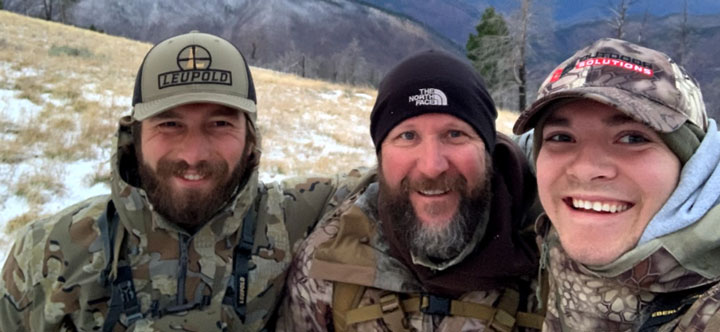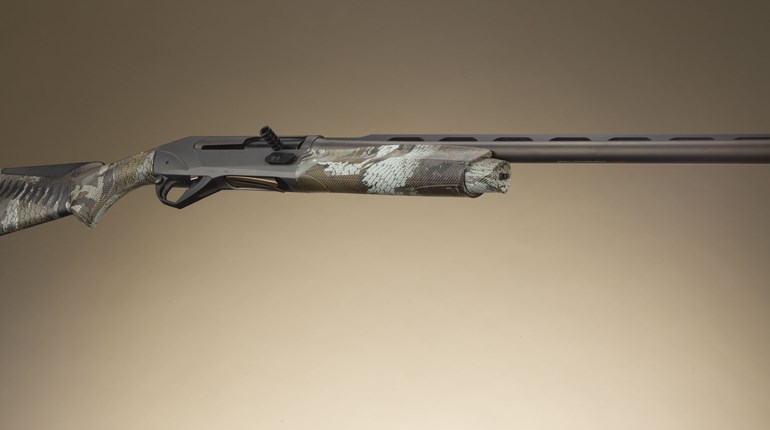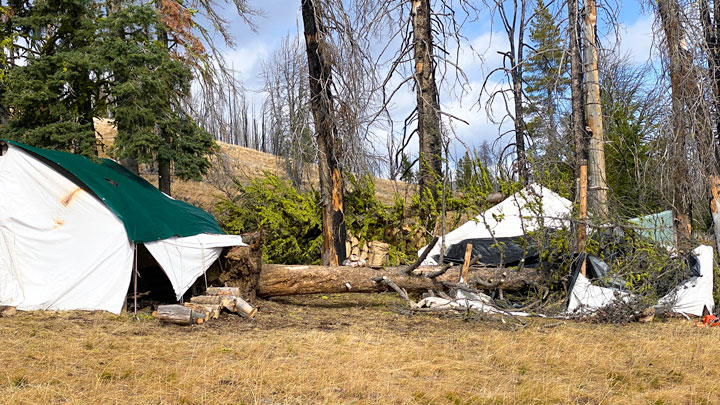
As I stepped off the plane in Missoula and collected my bags, I heaved a heavy sigh of relief. A few tight layovers and flight delays had made it nothing short of a miracle I arrived at all—much less on time—and I was beyond ecstatic to get moving. As I stepped out into the cool darkness of the Montana night, I met Greg Ray, founder of Outdoor Solutions, a long-range shooting school aimed squarely at hunting clientele. We, along with his son and videographer Eddie, were about to take a couple rifles on the test of a lifetime, hunting the rugged Idaho backcountry for elusive, world-class mule deer. My rifle of choice was the new Springfield 2020 Waypoint chambered in 6.5 Creedmoor. Shooting less than 1 MOA with the Hornady 143-grain ELD-X Precision Hunter I brought along, I was confident the rifle would prove more than adequate for the task at hand. As our rental wound southward through the serpentine mountain roads, I couldn’t have known that I was only half-right in my expectations. This hunt would absolutely be a test. But as it turned out, it would test us far more than our trusty rifles.

Day 1: Riding In
After a little extra shuteye and a late breakfast with our gracious hosts, we mounted an assortment of horses and mules, and followed our guides 3 hours into the very heart of the backcountry. I sat atop a sturdy, stubborn mount who shared my disused first name (Louis). With a stern hand and leg, Louis and I eventually gained a rapport as we ambled our way through the burned-out mountain forest. Reaching camp in late afternoon, we picked out cots, rolled out sleeping bags, lit a fire and settled into a warm meal, excited for the days that lay ahead.

Days 2-4: Hiking, Glassing, Hunting
Our initial three days of hunting saw a lot of glassing. We would hike out of camp early by light of the moon, heading a few miles either over or down the ridgeline (wind dependent), before staking out a hidden vantage to glass from. Lunch would see us build a crackling fire to warm sandwiches and dry gear, before resuming hiking and glassing in the afternoon. We did have a few periods of excitement—spotting a 170-class, and hearing the piercing howls of nearby wolves emanating from a ghostly fog-bank—but our days passed mostly in a mix of wind, sleet, snow and cheery camaraderie. These days of passive anticipation would stand in stark contrast to our experiences on the fifth day.

Day 5: Close Encounters; 0500-1730
The weather report promised one final day of wet and windy weather. Ecstatic at the coming change, we headed out early toward a hilltop over the ridgeline from camp. A close encounter with a 160-class bedded at 75 yards got our blood pumping, but unfortunately both wind and trees were against us, and he bounded away in a swirling breeze that revealed our presence. Exhilarated, we glassed a bit before kindling a lunch fire.
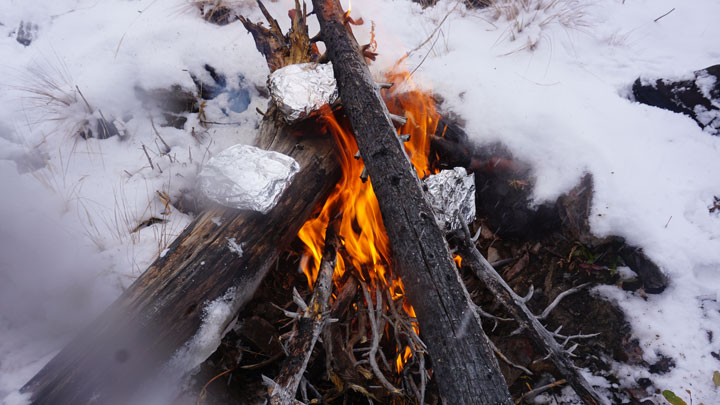
That afternoon, we struck gold some 2,000 yards away across three small draws. Three bucks, the smallest of which approached 170 inches, stood feeding on a dense hillside. We hurriedly repacked our gear, donned our packs and beat a forced march across the steep shale hillsides, which jutted like fingers from the main ridgeline, toward our quarry.
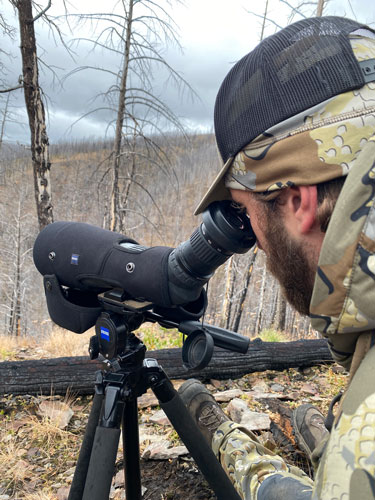
Day 5: Disaster; 1730-2359
The big buck never slipped. At one point, Greg had his shoulder in the crosshairs, but waited for one more step to plug the vitals. Alas, the buck doubled back behind his chosen tree, and never yielded another opportunity. Disappointed, but impressed by Greg’s steady patience, we snuck back out of the trees amidst the fading light, unaware things were about to get truly Western. As we climbed the steep shale, we noticed the wind begin to rise, sleet and ice pouring steadily from the sky. Just the last gasps of the storm blowing out, we thought. Making our way onto the barren ridgeline, however, we began to realize this was no typical storm.
The wind howled with a constant force between 50- and 70-mph as we crested the rise; dead trees, already devoid of their leaves, laid over in its path like slanted black toothpicks. A large stretch of forest still stood between us and camp, so we paused and surveyed the scene. In roughly two minutes, over thirty trees fell, many directly on the path we would have walked. It slowly began to dawn on us just what sort of shape we were in.
With no option but to press on, the bare ridgeline becoming more unlivable by the minute, we worked left, finding the narrowest, most sparse section of trees we could. On a “3…2…1…GO,” we ran for it, sprinting for our lives through the tumbling timber. We reached a clearing. The woods still closed for another quarter mile in front of us, but here we were safe to catch our breath. The day’s light now almost fully spent, we collected ourselves, gave another starting shout and ran again into the trees, this section denser and darker than the last.
Following a crude horse trail, we fast-rucked our way over and between already downed trunks. Halfway, two of us turned back to check in on those a few paces behind. A tree was coming down—as best we could tell in the near darkness, it was right above them. “RUN!” we shouted, and they picked up the pace, the tree crashing barely 10 yards to their rear. At last, we made the meadow above camp. Heaving a collective sigh of relief, we thought we were safe, but our night had only begun.
A tree was down already when we arrived, but it had missed everything but the woodpile. Our guide made his way into the mess to start dinner, and I began to follow, thinking I’d dry my gear in front of the woodstove. As he bent to enter however, the suppressor on his rifle caught the tent, making him pause to remove his pack. This split-second delay caused me to reconsider and instead head for my own tent, where I could remove my dripping-wet boots and start my own fire.
Plopping down on my cot, I peeled off my Lodestars and began to chat with the other hunters. The wind picked up. Suddenly, I saw Eddie lifted up on his cot. Thinking the tent was going skyward, I grabbed the main pole, only to realize Eddie’s cot was the only thing moving. A massive root ball appeared from the earth beneath him, jarring him to the side. The same moment I realized where that tree must have fallen, screams from the mess tent cut the air, and I feared the worst.
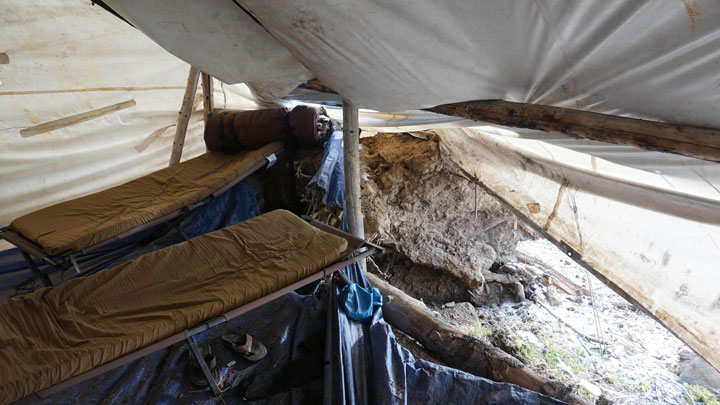
Greg and I bolted from our tent, vaulted the freshly fallen tree and rolled under the remaining wall of the mess tent, now some 75 percent destroyed with a massive fir across it. Our guide lay there, sprawled on his back, but thankfully, my worst fears were not realized. The tree had smashed his pack as he searched it for a headlamp, knocking him aside and tearing muscles in his back, but not pinning him. The woodstove I intended to warm my hands by had taken the full brunt of the tree’s weight and lay in pieces, smashed like porcelain upon the ground. The seats, where Greg and Eddie would have already sat had the deer not delayed us, had branches stuck through them. Helping the injured party to his feet, we shuttled him outside, as he urged us to all to get to the guide tent—the only one out of the path of any trees.
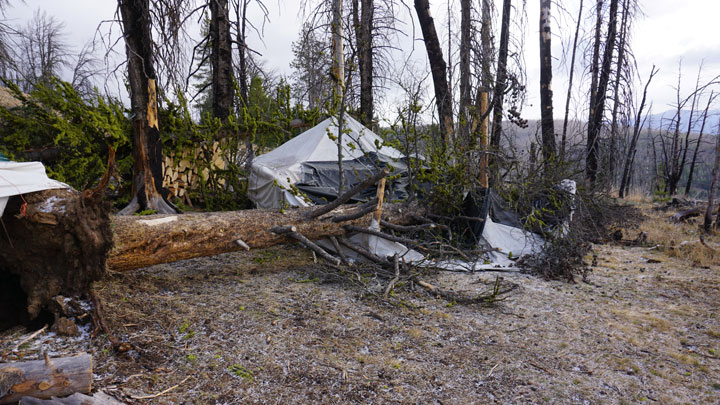
Issue was, if all the camp tents went down, we would be without any gear to keep warm. This in mind, Greg and I ran back into our tent to hurriedly pack essentials. Halfway done, our guide limped to the door. Impressively self-aware, he informed us quite calmly he was going into shock and needed a fire, STAT. Greg jumped to help him while Eddie and I continued to pack gear and sleeping bags. More trees went down.
Eddie and I had made several trips to the guide tent, and gathered most everything we’d need, when I realized I couldn’t feel my feet. I had removed my boots to dry before the tree went down, and never put them back on. I quickly shoved my feet in a bag to warm for a few minutes, as temperatures outside had dipped into the teens, before helping collect the last of the gear.
Everyone situated, we settled in for a wild night, the storm continually blowing the chimney from the stove until we managed to wedge it with a rock. Exhausted, I rolled my bag out on the dirt, set an alarm to feed the fire, and drifted off to sleep, wind howling to ever more hurricane-like speeds outside.
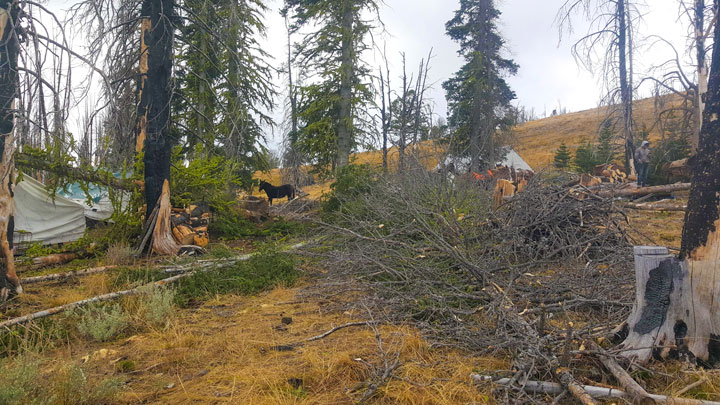
Day 6: Rescue
As the new day dawned, we surveyed the scene. The damage was absolute. “Woah, that sunrise is beautiful,” commented Eddie, always in good spirits, and despite the circumstances, I had to agree. The view encapsulated both the sublime splendor and terrifying power of the natural world, in an odd chiaroscuro of brilliant colors and broken timber.

The horses, thankfully, had survived, thanks to the outfitter’s practice of leaving them uncorralled. His guiding partner had started in from the road with a small coalition of hunters and ranchers around 0700. They would not reach us until around 1400, some 357 downed trees cut from the trail in their wake.
As we rode back out of the destroyed forest, more than a little thankful to draw breath, my thoughts bounced from the scenery, to the injured party, to the deer in my sights. Though I can’t speak in totality for the others, I know almost for a fact that we all shared one final thought …
I’ll see you next year, Idaho.
